'Best candidates' for lost Philae comet lander
- Published
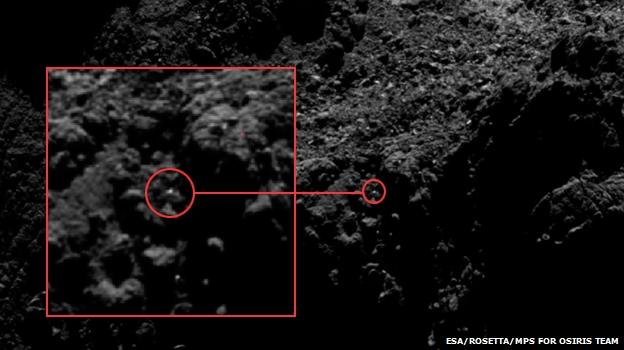
The best candidate could be just a glint off some bright surface material
The European Space Agency (Esa) has released some pictures that may include its lost comet lander, Philae.
Whether that really is the case is far from certain, however.
The features of interest in the images are on the scale of a few bright pixels and could very easily just be a trick of the light.
Philae was dropped on to the surface of Comet 67P by its mothership Rosetta in November last year, and has not been heard from since its battery ran flat.
The washing-machine-sized robot bounced a good kilometre from its intended touchdown point, hence the doubts about its current precise whereabouts on the 4km-wide icy dirt-ball.
Mission teams have a very good idea of where Philae ought to be - inside a patch of terrain measuring perhaps a few tens of metres across. But getting the photographic evidence to prove it is there has been very challenging.
Rosetta acquired a series of pictures of the suspected resting region back in December, and scientists have been poring over the data ever since.

"Before" and "after" comparison images of the most promising lander candidate
They have been looking for differences in this image-set compared with pictures taken before the landing, and Thursday's release from Esa represents what can only be described as "the best candidates" for Philae. One is rated higher than the others, but even this cannot be promoted with particularly high confidence, agency officials have told the BBC.
Even after some smart processing techniques were applied, it is still just a bright splodge. Esa has rendered a movie that zooms in on this top candidate (MOV), external to make it easier for people to discern the feature being discussed.
Stephan Ulamec, the lander manager with the German space agency, said recently: "In the best images we have after the landing, with the correct illumination and taken from an altitude of 20km - the lander would be in the range of two-times-three or three-times-three pixels. And this is exactly the problem: it's not very distinct. We have to assume there is some shadowing effect on the lander that will camouflage it.
"And, yes, the later in the evening and the more wine you drink - the more landers you're able to identify in this terrain," he memorably joked at this year's European Geosciences Union General Assembly in Vienna in April.
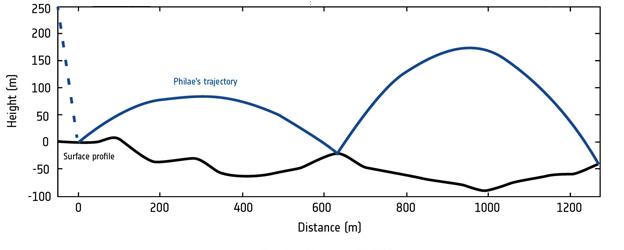
Philae bounced more than 1,200m across the surface before stopping in a ditch
Before it lost power, Philae itself returned images of its surroundings, which showed it was in some kind of ditch. The location, dubbed Abydos, is on the "head" of the duck-shaped comet.
High walls were blocking sunlight from reaching Philae's solar panels, denying the robot the ability to charge its battery.
The mission teams must now hope that those illuminations conditions will improve as Comet 67P moves closer to the Sun in the course of the next few weeks. They should. And if Philae can muster enough charge to boot up, the orbiting Rosetta will be listening for even the briefest of radio communications.
The first contacts - if they come - will be short because the battery will almost immediately die again as the transmitter equipment is fired up. But in time - perhaps by July - Philae could be getting enough intense sunlight to generate a useful amount of electricity.
The big concern, however, is the cold. For many of the lander's components this is not a problem, but there will be electronics that have experienced temperatures in the past few months that are below their "qualified" limits. This will include the onboard computer and the communications unit, both of which sit inside a so-called "warm compartment".
"A problem one may face with these low temperatures is some thermal stresses on the electronics boards, and they may damage soldering points," Dr Ulamec explained.
"All the instruments and mechanisms that are outside the warm compartment - they are qualified for very low temperatures because we were expecting those even if we had landed in the planned landing location."
Mission teams had the idea to send Rosetta on a quick, close flyby of the suspected resting place this month, to acquire new images with a higher resolution than those featured on this page. But this possibility has long since been abandoned. So much dust is coming off the active comet that Rosetta's navigation systems get confused if the probe ventures too close.
Rosetta has been pulled back from 67P and currently keeps a watching brief from a distance of about 100km.
The probe's distance from Earth is about 309 million km, and about 218 million km from the Sun.
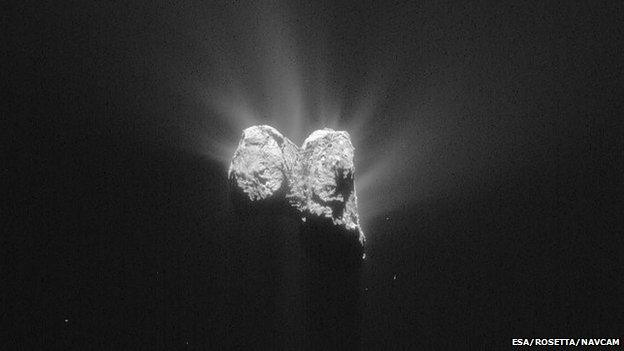
Comet 67P is now throwing out a lot of dust as it journeys in towards the Sun
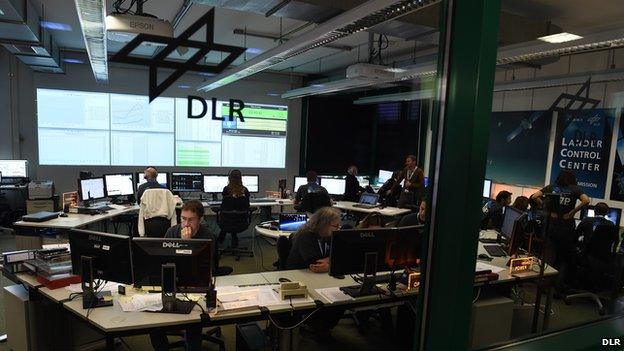
Philae lander operations are managed by the German space agency in Cologne
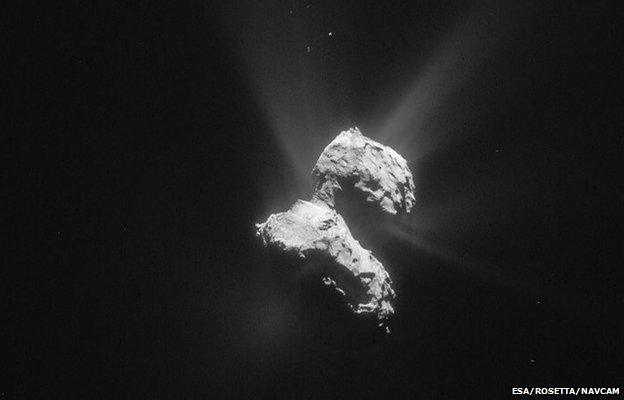
If the comet is thought of as duck then Philae is somewhere on the head
Jonathan.Amos-INTERNET@bbc.co.uk and follow me on Twitter: @BBCAmos, external
- Published20 April 2015
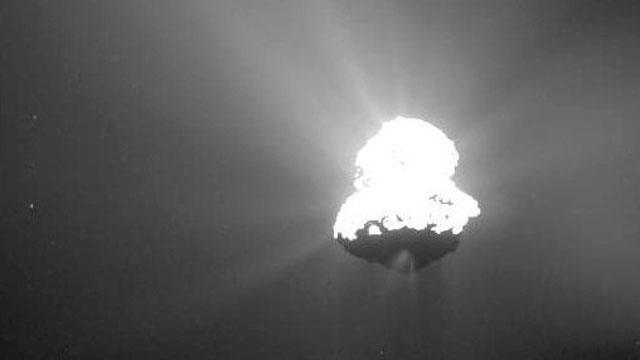
- Published14 April 2015
- Published20 March 2015

- Published17 March 2015
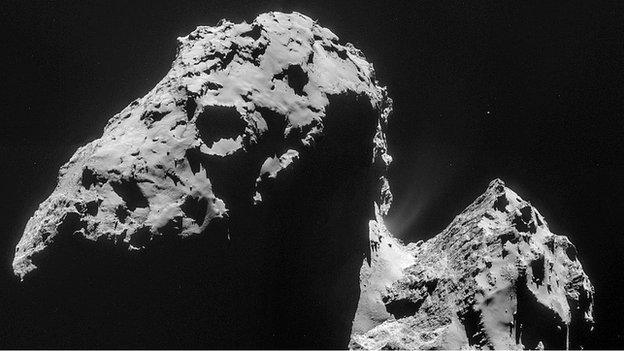
- Published3 March 2015
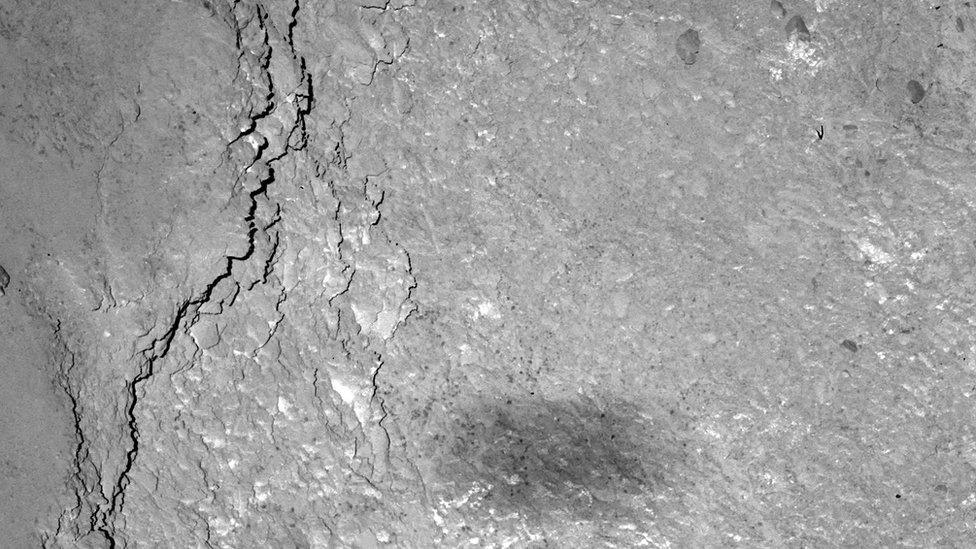
- Published30 January 2015
